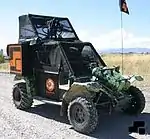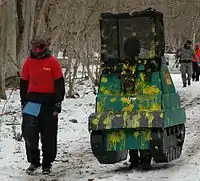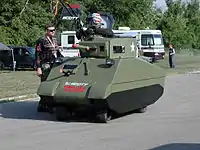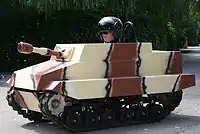Paintball tank
A paintball tank is a vehicle, or a portable structure that resembles a vehicle, used in various types of the sport of paintball, usually with the intent of military simulation. The purpose of a paintball tank is to provide a mobile shelter for one or several players, from which they may employ their markers against players on the opposing team. Small pneumatic guns, effectively low-powered potato cannons loaded with foam darts, are also often employed as anti-tank weapons.

Paintball tanks are commonly used for woodsball and scenario paintball games, and similar designs have also seen use in Airsoft scenario games, with varying degrees of similarity to a true tank.
The use of the term tank does not mean that the vehicle must resemble a tank, or even that it has tracks, or an engine, or wheels. As long as the finished product is functional within the boundaries of gameplay and safety rules, and has the appearance of some form of military vehicle, it can be referred to as a tank. For this reason, a tank may often be referred to as a paintball armoured vehicle (PAV). Although motorized designs built on the chassis of ATVs, golf carts, or automobiles may have similar internal layouts, the large amount of creative freedom involved in their design and assembly results in great functional and visual variation between vehicles. For this reason, tanks are usually type classified by the method of propulsion rather than functionality or aesthetics. These types include muscle-powered personal armor ("Pugs") and bunkers on wheels, and motorized designs that may or may not be built around the chassis of off-road vehicles and automobiles with various forms of structural and aesthetic alteration.
Types and construction
The purpose of a PAV is to provide a mobile shelter for one or several players, who may thus advance and fire upon the opposing team while being immune to hits from opposing players' paintball markers. Although the method of propulsion, the crew size, the physical size and weight, and the number and location of weapons vary depending on tank type, all tanks share some common features.
General construction
Tanks feature a hull assembled from thin plates of paintball-resistant material such as laminated cardboard, plywood, fiberglass, or sheet metal attached to a rigid frame. The frame may be built from PVC or ABS pipe, wood, or steel tubing. In some cases, a monocoque or semi-monocoque structure may be used.
Tanks usually have large openings in their hulls through which the crew can observe their surroundings. These openings are commonly covered by netting, or sometimes thick panes of plexiglass (though to stop paintballs from entering the tank. In some cases, the tank may be entirely covered in netting. Less extreme cases have net-covered structures extending from the hull to let tankers poke their heads out of the vehicle without said heads being completely exposed to incoming paint, mandatory goggles and masks aside.
A tank's armament usually includes two or more paintball markers, and may include a low-velocity pneumatic gun loaded with foam projectiles for use against enemy tanks, and/or canister shot containing several paintballs inside a flimsy paper or foam packaging or sabot, to be used against opposing infantry. Rules permitting, the main gun may also be used against buildings occupied by opposing players.
Types
Tanks are classified according to their propulsion method, though some events may provide additional temporary classifications depending on physical size, crew size, or armament. These event-specific classifications do not change the physical characteristics of a tank, but do change the rules regarding how a tank is used, moved, and defeated in combat. A tank's type classification may or may not be indicative of the tank's size, crew capacity or other capabilities. For example, automobile-based designs are usually the largest because of the dimensions of the vehicle they were built on.



Scratch-built
These tanks are custom-built from the ground up, and as a result of the incredible freedom of design and influence of imagination involved in their creation, this group is the most diverse of all.
- Walking tanks are generally built for smaller scenarios and fields. Less a tank and more a protective covering for the occupant, walking tanks are the most common type. Weight concerns usually limit their armament to a pair of paintball markers, and occasionally a pneumatic gun. While lacking the visual impressiveness of other designs, Walking tanks can be cheap to build and easy to transport, while providing much the same benefit as a more complex design. Walking tanks have been commonly referred to as PUGs after one builder produced what he called a Panzer Ultraleicht Gepack (very light backpack armor) constructed using a military backpack as a base.
- Carry-along tanks are multiple-occupant walking tanks or Flintstone tanks without wheels, and are carried around on the field by their crew whenever movement is desired. These designs sacrifice either structural durability, armament, ammunition, crew comfort, or a combination of these, for increased off-road mobility when compared to a Flintstone tank. They commonly have several firing ports in the walls of their hull, and a pneumatic anti-tank gun may be attached to the tank, or carried by a crewman.
- Flintstone tanks, also known as "push tanks", are multiple-occupant bunkers on bicycle or trolley-type wheels. As the name suggests, they are moved around by the crew grabbing a hold of the tank's interior and pushing it in a desired direction. Although generally poorly suited to uneven terrain, they can be fitted with heavier equipment than a walking tank, including manned turrets.
- Motorized scratchbuilt tanks can be of virtually any size and internal layout, although most are fairly small. Some are designed as scale replicas of historical or modern tank designs, others for performance. They're generally built on wood or tube-frame chassis, and powered by a small industrial engine. Some of the more involved versions feature working tracks and motorized turrets.
ATV-based tanks
ATV-based tanks are ATVs fitted with weapons and protective coverings. The level of involvement varies here as well; some are simply quads or similar fitted with a removable netting cage, others feature scratch-built bodies and turrets and are capable of housing several players and their equipment. All-terrain vehicles, Golf carts, riding mowers and amphibious ATVs are the most popular bases for ATV tanks, thanks to ready availability, off-road ability and low price.
Automobile-based tanks
Automobile-based tanks are modifications to existing automobiles; ranging from minivans with firing ports and windows replaced by netting to near-replica vehicles featuring completely new bodies. The most common base vehicles are SUVs, Jeeps and trucks due to low cost and availability, although their high ground clearance and four-wheel drive is also helpful given poor conditions of many trails and roads in paintball fields. Minivans are also a common sight.
Rules and game involvement
While paintball has standardized (and very strict) safety rules relating to markers, masks, and other equipment used by players, putting those players, their markers and masks, and additional equipment in an enclosed vehicle (motorized or not) creates additional safety concerns. The following is an aggregate of rules which may or may not all be in use at the same time at any particular field,
Awareness
- Tanks are required to have a Tank Walker; a referee who walks next to the tank and enforces player proximity restrictions, alerts the driver if a player is at risk of being run over, points out terrain obstacles, informs the crew when their tank is hit by enemy antitank weapons and inform enemy tanks and bunkers when they have been hit. Walkers are however not allowed to point out targets to the tank crew, and as implied by their referee status, do not carry any weapons of their own.
- Since the tank crew's arm bands or other team identifiers are not typically visible to players outside the tank, the tank itself must also carry team identifiers. These come in two varieties, the first being markings placed on either side of the vehicle, preferably on a turret, and a marking on the front of the hull, the height and width of these markings being no less than 8" or 20cm, at least 25% of the vertical height of whichever surface they're mounted or painted onto, and at least 12,5% of the height of the vehicle from the ground up to the roof of the hull or turret (whichever is higher). The second option is to fly a 2' by 3' team flag* on top of the vehicle to be visible from all directions.
- Tanks must fly a white 2' x 3' flag* to indicate their eliminated status while travelling back to a reinsertion point.
- If rules do not prohibit players from approaching an immobile tank, motorized tanks must sound a horn before starting the engine, and must wait for the walker to give an all-clear signal.
*Some fields allow smaller 2' x 2' flags.
Movement
- Speed limits are generally considered among the more important rules for paintball tanks, especially for motorized tanks. It is a common rule to restrict tanks to 8km/h, 5mph, or "Walking speed" on the field.
- Motorized tanks may be limited to travelling on roads. What is or is not considered a road is determined by the owner of the field.
Armament
- The driver of a motorized tank may not use their marker unless the tank is stopped and the engine turned off.
- If the field allows the use of a tank's main gun against buildings housing players from the opposing team, only hits to the outer walls of the building are counted. This is to disincentivize lobbing shots in through windows as a high-speed foam dart may carry enough energy to knock off a mask.
- A tank's markers should be semi-automatic. One trigger pull: One paintball.
- Fields may standardize cannon and AT rocket ammunition, in which case non-standard ammunition may be banned. The following is a list of common ammunition types:
- AP shot: A foam dart up to the size of a Nerf vortex dart. The most common type of ammunition.
- Canister: A foam or paper cartridge holding several paintballs which separate upon leaving the cannon barrel. Incredibly inaccurate but useful as a psychological weapon because of the high probability of hitting something, somewhere.
- HE shell: A foam or paper cartridge or repurposed water balloon filled with powder and/or paintballs. Unlike foam darts, these shells are unlikely to go unnoticed as they burst on impact.
- Smoke: A fragile bag of powder, typically flour. Bursts upon firing and creates a visual obstruction. Smaller smoke launchers may also be mounted on the hull or turret to produce an arc of smoke around the vehicle.
Elimination
- Tanks may be eliminated by direct hits from pneumatic guns mounted on other tanks, stationary anti-tank gun emplacements, or by handheld versions carried by infantry.
- Tanks may be fitted with coloured panels on their sides and rear at the start of play, and knocked out of action once one or several of these panels are entirely covered by the opposing team's paint.
- Tanks may be fitted with nets into which the opposing team must fire foam darts to eliminate the tank.
- Tanks may be eliminated by vehicle mines and satchel charges.[2]
- Tanks are required to replace their team's flag with a white flag once the tank has been knocked out of action.
- A tank's crew may or may not be eliminated by direct hits to their person (Clothes, facemask or marker. Markers which are physically attached to the tank are considered part of the tank and are immune to paint).
- A tank's driver may be considered a part of the tank, if this is the case, the driver cannot be eliminated.
Player Interaction
- Players may not be allowed to be closer than 4,5 - 6m (15 - 20 ft) from a motorized tank. Sometimes this rule only applies to moving tanks. Sometimes it applies to everything except PUGs, Carry-along, and Flintstone tanks.
- Players are not allowed to climb onto, into, or out of the tank during movement.
- Tank Storming; the act of physically assaulting the tank crew rather than the tank itself, may be forbidden. Actions that constitute tank storming includes, but is not limited to inserting a marker into the tank and painting the occupants, and tossing paint and smoke grenades into the tank. Not all paintball players are able-bodied, and some may have difficulties climbing into or out of a tank unassisted even when it's standing on even ground and isn't filled with smoke.
Construction Requirements
Closely related to the game rules, these are rules which tanks must follow in order to even be allowed to enter a play area. Much like the game rules, the use or non-use of some of these rules depends on where and when the game is being played
Assembly
- The tank's construction must be structurally sound. Although technically vague, this rule may be generally understood as "If the vehicle was to flip onto its side, the hull and chassis should not separate or collapse".
- The skin should be impervious to paintballs. Ideally it should also be impervious to people leaning on it, although weight concerns may restrict both Carry-along tanks and Flintstone tanks to light materials such as laminated cardboard panels, foam, fiberglass, stretched cloth, or netting. PUGs, effectively being suits of armour rather than vehicles,
- All components not integral to the tank.(batteries, air tanks, ammunition storage,) should be strapped, bolted, or otherwise restrained from moving around.[3]
- There should be no exposed sharp points or edges on the tank's exterior. Such features should also be avoided inside the tank.
- Electric wiring should not be placed where it is likely to get caught on the crew's clothes or equipment, and should be generally neat and tidy.
Awareness
- Tanks, especially motorized ones, may be required to provide a certain level of visibility for the crew so as to avoid accidents involving tanks obliviously driving into or over players.
- Functional Head and tail-lights may be required for nighttime operations.
- A tank may be required to have a functioning radio transmitter/receiver to facilitate communication between driver and Tank Walker.
- Wheeled tanks must have horns with which to announce their presence to players in their path.
Mobility
- Tanks are required to have working brakes (PUGs and carry-along designs get away with "not walking" and "putting the thing back on the ground")
Firepower
- Tanks are required to carry barrel covers on all weapons when not inside a combat area. This rule applies to everyone, not just tankers.
- Tanks with pneumatic guns must abide by certain rules regarding what ammunition may be used and at which muzzle velocity. Rules may also apply to how the pressurized air is stored.
- The number of paintball markers mounted on tanks may or may not be limited, but the muzzle velocity of the markers themselves are limited for reasons of safety (use of excessively high rates of fire may also be considered unsportsmanlike conduct).
- The amount of ammunition carried in the tank may also be limited.
Emergency
- Motorized tanks must carry a (non-expired) fire extinguisher.
- Motorized tanks must have a Big Red Button mounted in an easily accessible location on their hull to allow anybody to disable the tank's engine and electronics if the driver in incapacitated.
Tankball
Tankball is a variation of paintball in which players drive modified full-size tanks and fire paint-filled ping pong balls, paintball Buckshot, or Nerf Rockets at another tank. Each battle pits two tanks against one another, and each tank can contain three or more teammates. Tankball is a much more expensive game than Paintball, and is therefore far less common.
Currently there is only one place the game is available, Leicestershire in England where paint-filled ping pong balls (with a diameter of 40mm) are used as ammunition, in combat restricted to tanks (actually FV432 Armoured Personnel Carriers). Closed-hatch operation is mandatory as the paintballs have too much kinetic energy to safely impact unprotected persons.[4]
External links
- Paintball Battle Tanks - Manufacturer of Recreational Tanks
- Paintball Tankers Association Rules and Information
- http://1sspanzerkorps.com/(%5B%5D a current and up to date paintball tank forum)
- Armored Fist Paintball
- Warpig Tank Forum
- www.tankball.co.uk
- www.armourgeddon.co.uk
- ABC news article
- Gizmodo article
- www.funtrak.co.uk
- Walking Paintball Armored Vehicles
- Scaled Tanks Details on building 1:5 and 1:2 scale tanks (Registration required)
- Treadhunter review of Tank Paintball
References
- <http://www.specialopspaintball.com/articles/razorback.asp]
- "Tank Rules". Fulda. Retrieved 2017-11-30.
- "Supergame". supergame.tv. Retrieved 2017-11-29.
- Tank Paintball